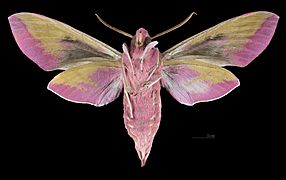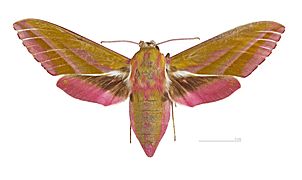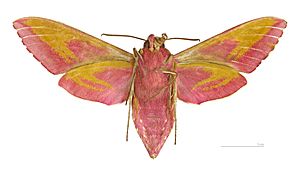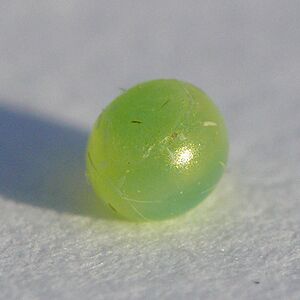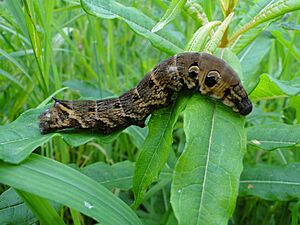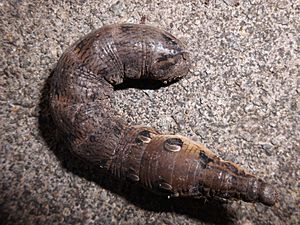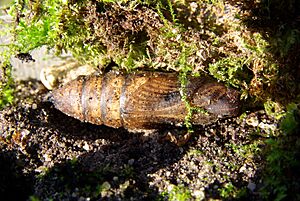Elephant hawk moth facts for kids
Quick facts for kids Elephant hawk moth |
|
|---|---|
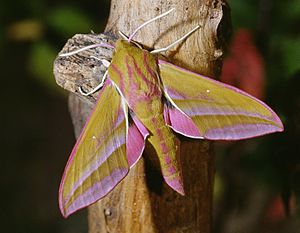 |
|
| Scientific classification |
The elephant hawk moth (Deilephila elpenor) is a beautiful moth known for its bright olive and pink colors. It gets its name because its caterpillar looks a bit like an elephant's trunk! These moths are very common in central Europe and can be found across a large area called the Palearctic realm.
Elephant hawk moths are active at night. They visit flowers that open or produce nectar after the sun goes down. They have amazing eyes that can see colors even in very dim light. In fact, they were one of the first animals discovered to have color vision at night! These moths are also great at hovering in the air while they sip nectar from flowers. This hovering takes a lot of energy, so their excellent eyesight helps them find food quickly and efficiently. They are also important pollinators, helping plants reproduce.
Contents
- What Does It Look Like?
- Types of Elephant Hawk Moths
- How Is It Different from Similar Moths?
- Where Do Elephant Hawk Moths Live?
- What Kind of Places Do They Like?
- Life Cycle of the Elephant Hawk Moth
- Special Features (Adaptations)
- How Do They See?
- How Do They Eat?
- How Do They Fly?
- Who Are Their Predators?
- Images for kids
- See also
What Does It Look Like?
The elephant hawk moth has olive-brown front wings with pink edges. You'll also see two pink lines crossing these wings. One line is usually thicker and ends near a white dot in the middle of the wing. The other line starts near the white inner edge and goes all the way to the wing tip.
Its back wings are black on the inside and gradually turn pink towards the outside, with white fringes. The moth's head, body, and the part behind its head (called the thorax) are also olive-brown with pink markings.
Types of Elephant Hawk Moths
There are a few different types, or subspecies, of the elephant hawk moth. Most of them are now considered to be the same main type, Deilephila elpenor elpenor. However, one subspecies, Deilephila elpenor macromera, is still considered a separate type. You can find this one in southern China, northern India, Bhutan, and Myanmar.
How Is It Different from Similar Moths?
People sometimes confuse the elephant hawk moth with the small elephant hawk moth (Deilephila porcellus). But there are easy ways to tell them apart!
- Size: The small elephant hawk moth is, as its name suggests, much smaller.
- Color: The small elephant hawk moth has more yellow on its body.
- Stripe: The easiest way to tell them apart is by looking at their bodies. The elephant hawk moth has a thick pink stripe running down its body, which the small elephant hawk moth does not have.
These two moths usually live in different places. The small elephant hawk moth prefers more open areas, so you won't often find them together.
Where Do Elephant Hawk Moths Live?
The elephant hawk moth is very common in central Europe. It lives all across the Palearctic realm, which includes Europe and parts of Asia. They are especially common in England, Wales, and Ireland.
Until the 1980s, they were mostly found in the southern part of Scotland. But now, they have spread further north along the coast and into the mainland of Scotland. Generally, you'll find fewer of them the further north you go in Europe. Their range also stretches across Asia, all the way to Japan.
What Kind of Places Do They Like?
Elephant hawk moths can live in many different places. These include grassy fields, heathlands, sand dunes, hedgerows, woodlands, open countryside, and even gardens in cities!
They play a very important role in these habitats as pollinators. Studies on hawk moths show that they can pollinate a good number of tree and shrub species in the areas where they live.
Life Cycle of the Elephant Hawk Moth
Usually, there is only one generation of elephant hawk moths each year. Sometimes, a few moths from a second generation might appear in late summer, but this is rare. The moths are active from May to early August, with their busiest time being between June and September.
Egg Stage
Female moths lay their eggs one by one or in pairs on the leaves of plants that caterpillars can eat. These plants include rosebay willowherb (Chamaenerion angustifolium) and bedstraws (from the genus Galium). The moths also like human gardens, so eggs are often found on garden fuchsias, dahlias, and lavender plants. The eggs are a shiny whitish-green color and usually hatch in about ten days.
Larva (Caterpillar) Stage
When they first hatch, young caterpillars are yellowish-white or green. As they grow bigger, they turn a brownish-gray color with black dots along their bodies. Fully grown caterpillars can be up to 3 inches (7.62 cm) long. They also have a small horn-like spine on their last body segment that curves backward.
Sometimes, you might see a green version of the fully grown caterpillar in nature. Scientists are still trying to understand why some caterpillars are green and others are brown-gray.
Pupa Stage
It takes about 27 days for the caterpillar to change into a pupa. When caterpillars are fully grown, they look for a safe place to pupate. This is usually at the bottom of a plant, among plant bits, or just under the ground. Once they find a spot, they make a small chamber with a few silk threads. They then turn into a pupa and spend the winter in this stage.
The pupae are brown with darker brown spots, and the lines between their body parts look black. They are about 40–45 mm long.
Adult Moth Stage
Adult elephant hawk moths found in Europe usually have a wingspan of about 60–70 mm. There isn't much difference in size or appearance between male and female moths.
Adults are most active during June. They fly from dusk until morning, visiting flowers and drinking nectar. They especially like plants like honeysuckles (lonicera).
Special Features (Adaptations)
Eyespots on Caterpillars
Many insects, like moths and butterflies, have evolved special markings called "eyespots." These are dark, round spots that look like the eyes of a predator. You can find them on caterpillars' bodies or on adult moths' wings. These spots are thought to scare away birds that might want to eat them. It's a clever trick called mimicry.
When an elephant hawk moth caterpillar feels threatened, it widens the front part of its body. This makes its eyespots look bigger and more noticeable. Some scientists think this makes the caterpillar look even more like a snake, which helps scare away predators.
How Do They See?
Elephant hawk moths have incredibly sensitive eyes that let them see colors even at night! Most animals, including humans, lose their ability to see colors well in dim light. But elephant hawk moths can still use all their color-sensing cells (photoreceptors) in different light conditions. This means they have "scotopic color vision," which is the ability to see color in very low light. They were the first animal where this amazing ability was discovered!
Even though their eyesight is super sensitive, they can still see details quite well. This nighttime color vision is very important for them because of how they find food. Elephant hawk moths feed in the darkest hours of the night. They also hover in front of flowers to drink nectar instead of landing on them. Finding the right flower and hovering steadily are both tasks that need excellent vision.
How Do They Eat?
Elephant hawk moths eat nectar from flowers. Most insects land on a flower to get nectar. But elephant hawk moths hover in front of the flower. They then unroll their long, straw-like tongue, called a proboscis, to reach the nectar. While hovering, their wings beat very fast to keep them steady in the wind. This type of flight uses a lot of energy, so it's important for them to find nectar efficiently.
Using Their Eyes to Find Food
Since they are nocturnal, these moths tend to feed on flowers that open or produce nectar at twilight or during the night. These are often called "hawkmoth flowers." Elephant hawk moths can see colors, which is unusual for most nocturnal species. Their special vision helps them tell the difference between different colors even in low light. This helps them find the right flowers when they are looking for food.
Using Their Sense of Smell to Find Food
Their sense of smell, or olfaction, is also very important for finding food. Many hawkmoth flowers have a pleasant smell. Studies have shown that the smell of these flowers encourages the moths to search for them. So, scientists believe that both sight and smell help elephant hawk moths find their meals.
Learning How to Find Food
Like many insects, elephant hawk moths can learn and change their behavior based on their environment. Experiments have shown that they can learn to tell the difference between different colors and remember which colors lead to a food reward. This learning is very important because choosing the wrong flower can waste a lot of time and energy.
In one experiment, scientists used artificial flowers of different colors. If a flower didn't give any nectar, the moth would stop visiting that flower. This shows how important it is for the moth to save energy while looking for food.
How Do They Fly?
Elephant hawk moths are most active in flight between June and September. Since they are nocturnal, they fly from dusk until morning. Then, they rest at one of their food sources until dusk comes again.
These moths can fly quite fast, up to 4.5 to 5.1 meters per second. Wind makes it harder for them to fly and uses up more of their energy. Because of this, elephant hawk moths stop visiting flowers when the wind speed reaches about 3.0 meters per second.
They are especially good at hovering, which is a key skill for getting nectar. They use visual clues and special cells in their brains that detect movement to stay steady in the air.
Who Are Their Predators?
Some animals that hunt at night use bright colors to attract their prey, including the elephant hawk moth. For example, the white stripes on the head of the brown huntsman spider can lure flying moths to them.
Bats are also known to hunt and eat these moths.
Images for kids
See also
 In Spanish: Gran esfinge morada para niños
In Spanish: Gran esfinge morada para niños



